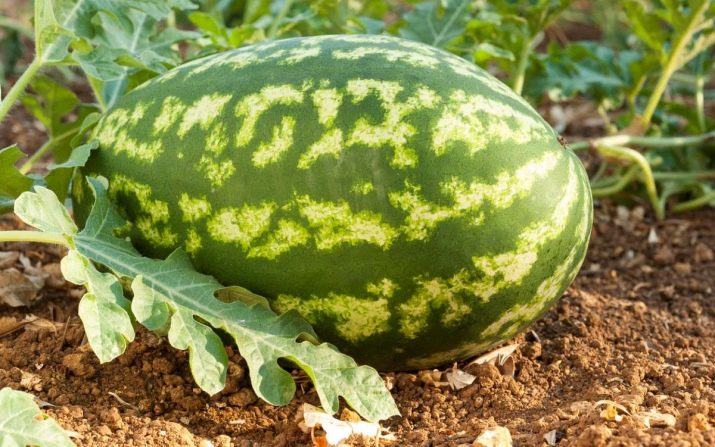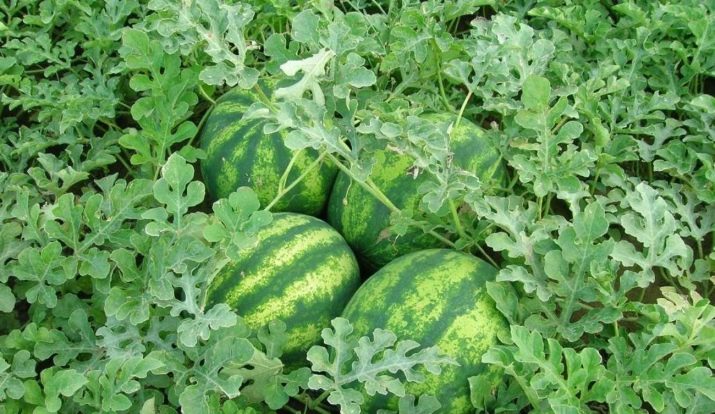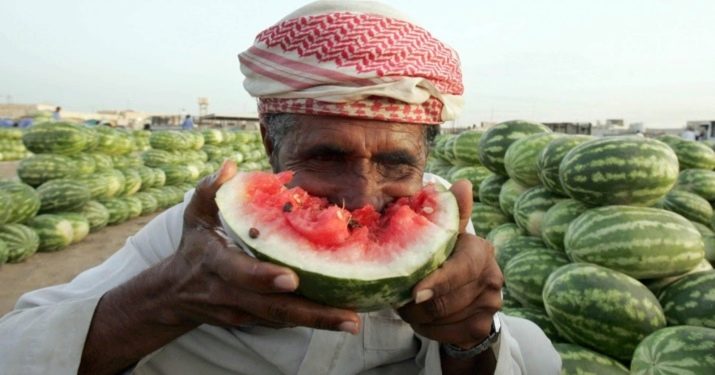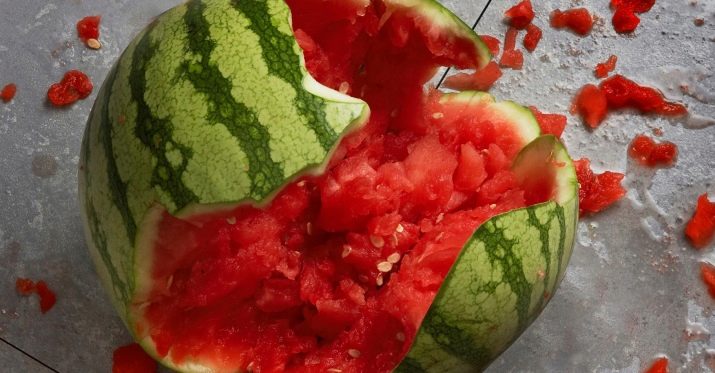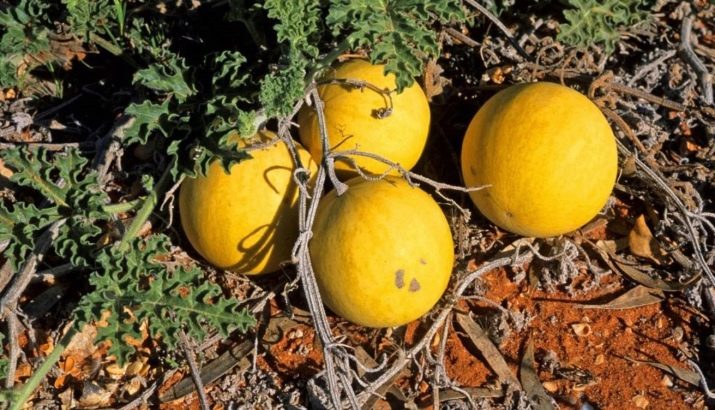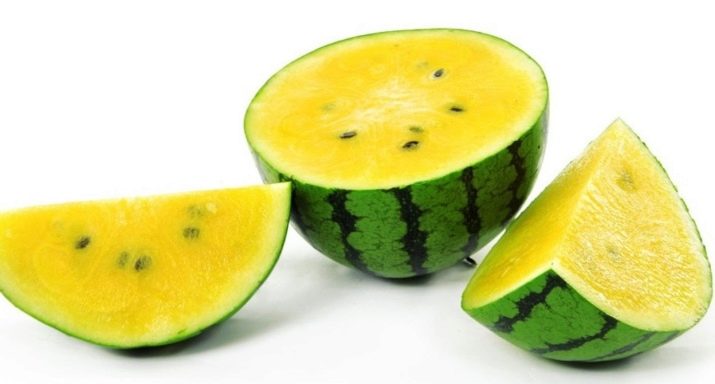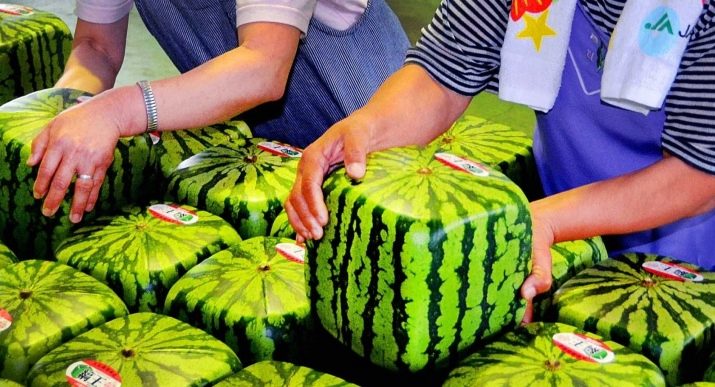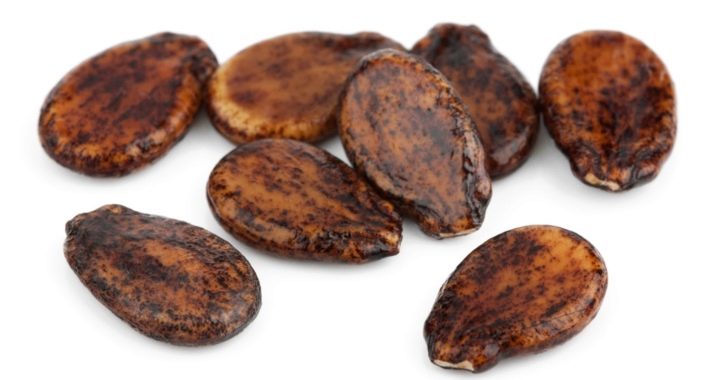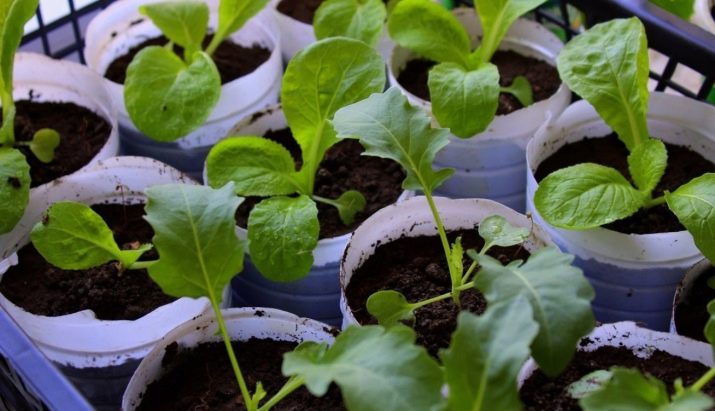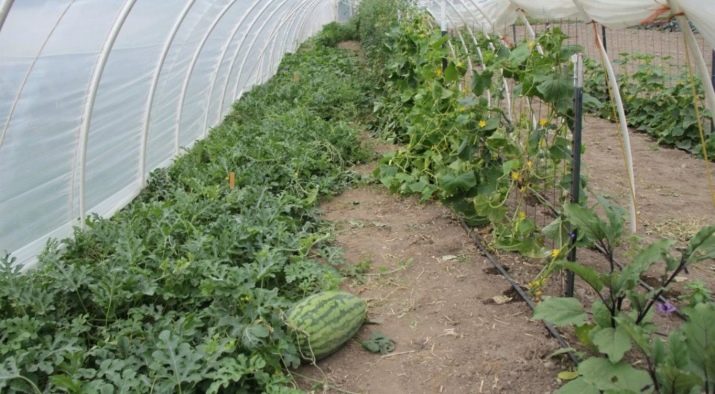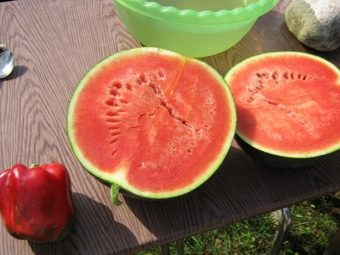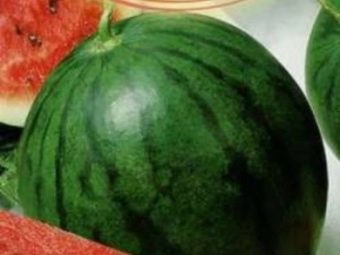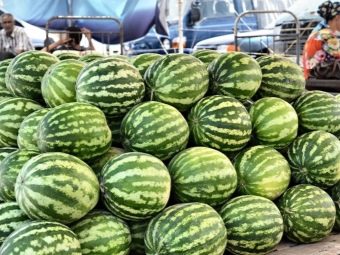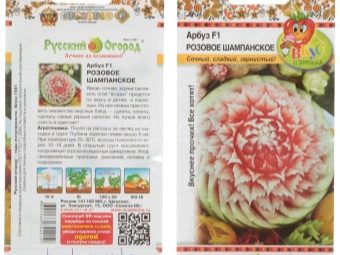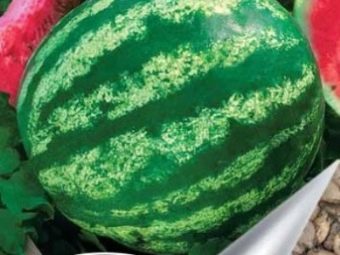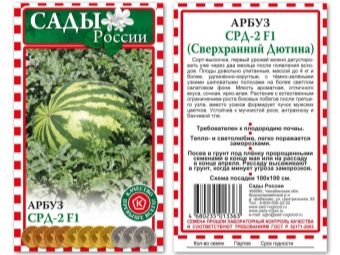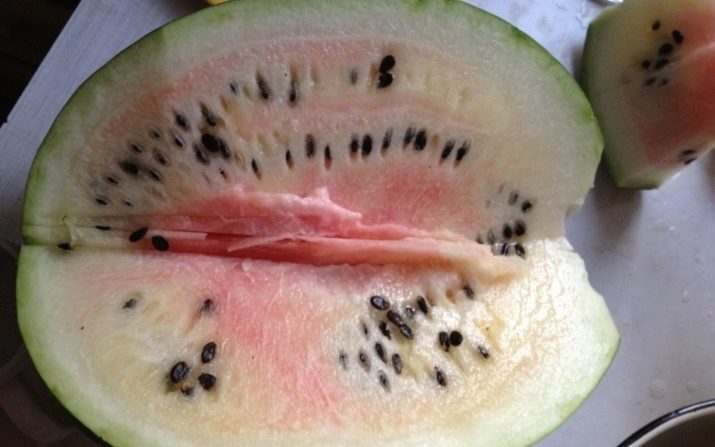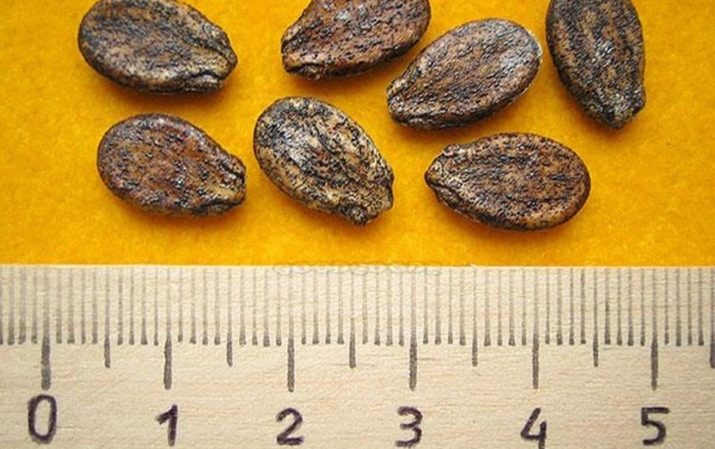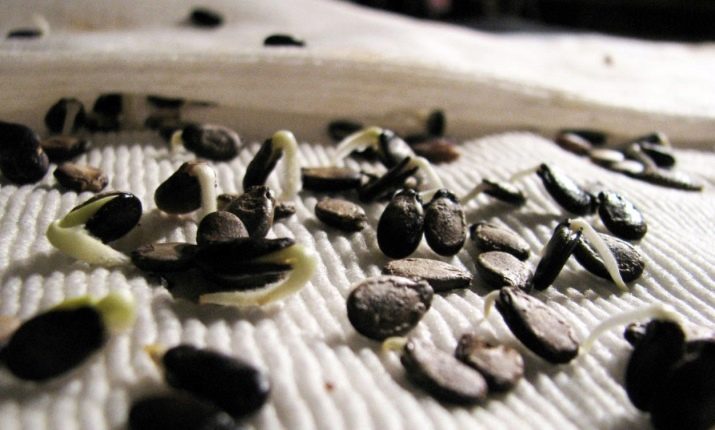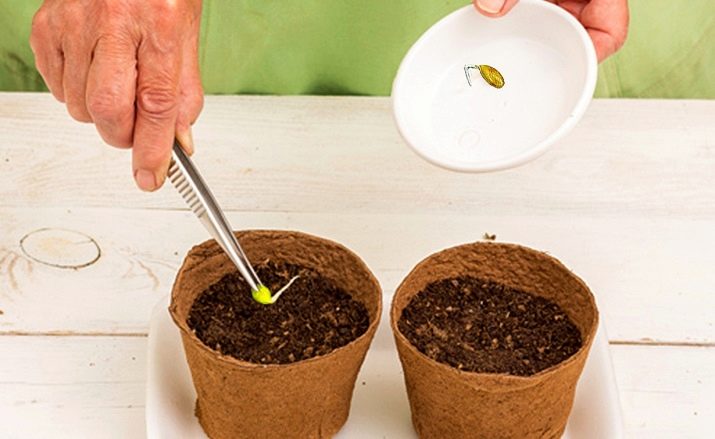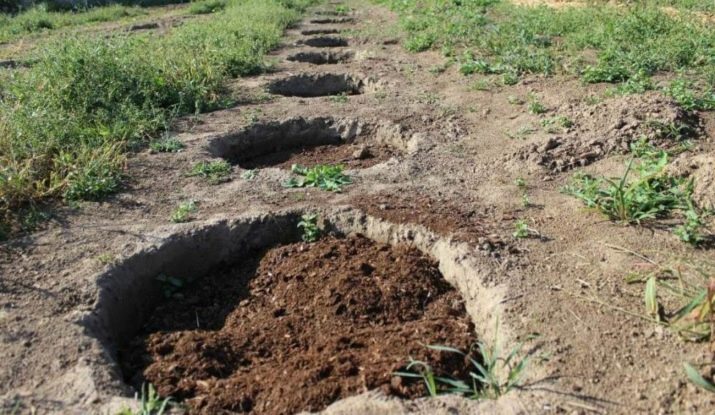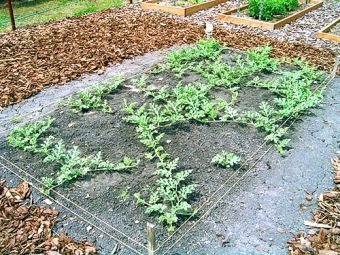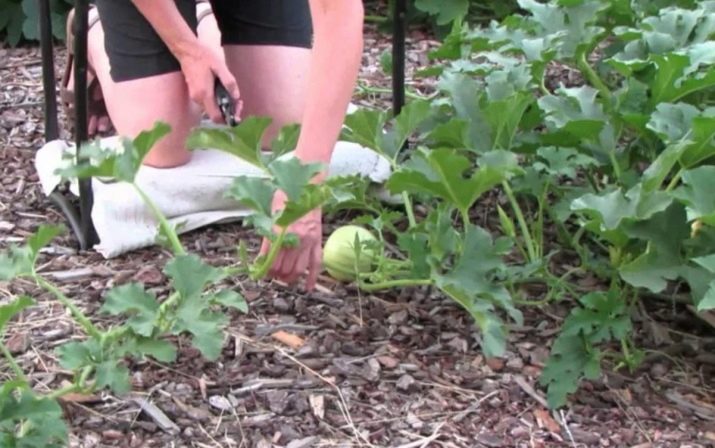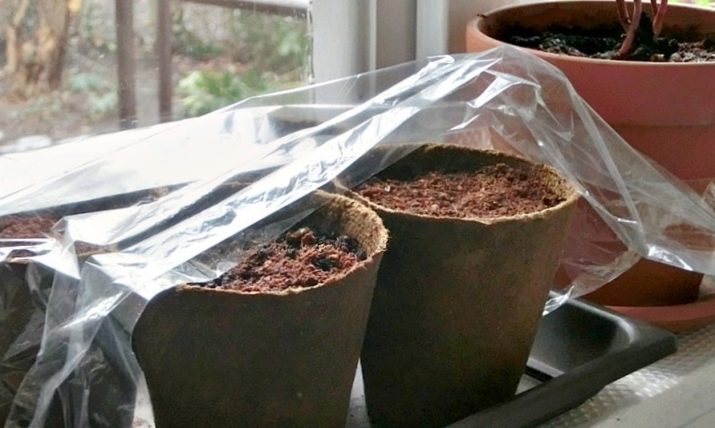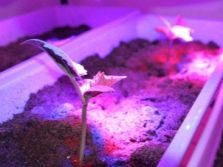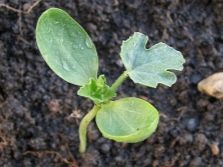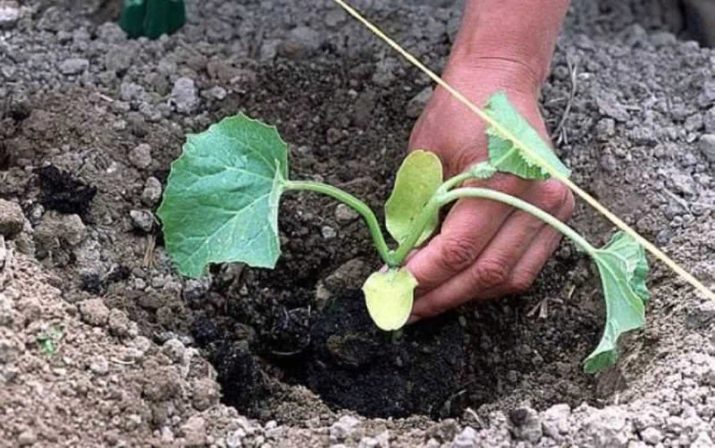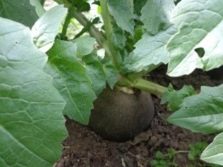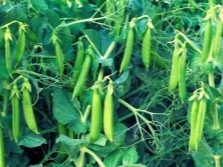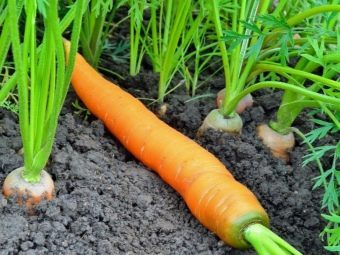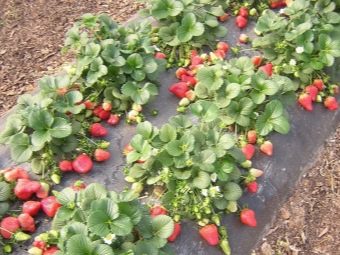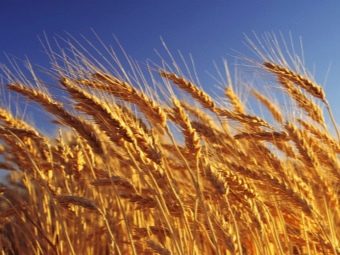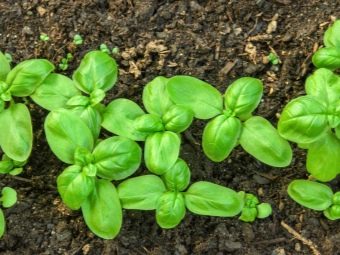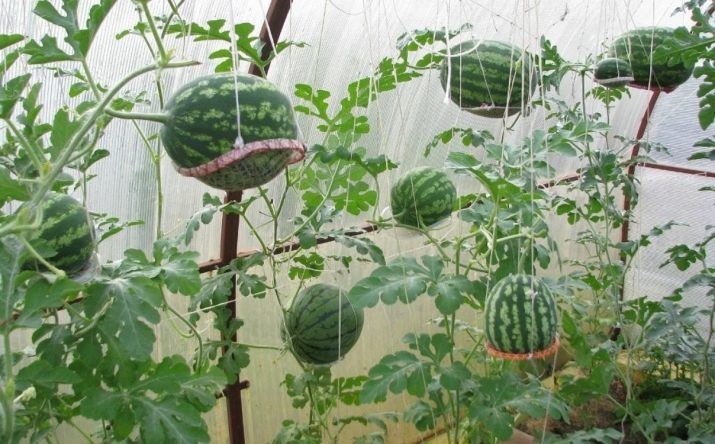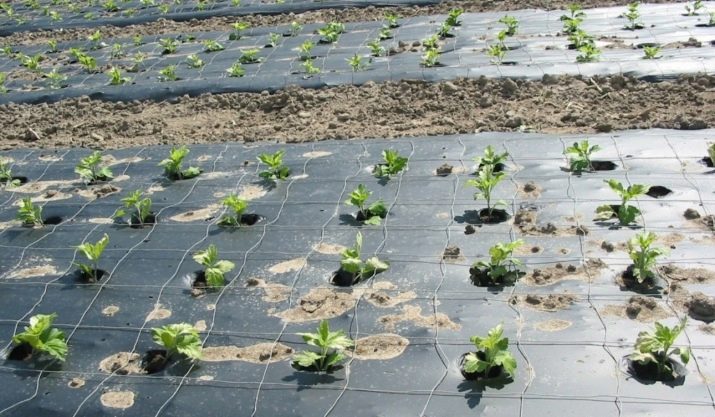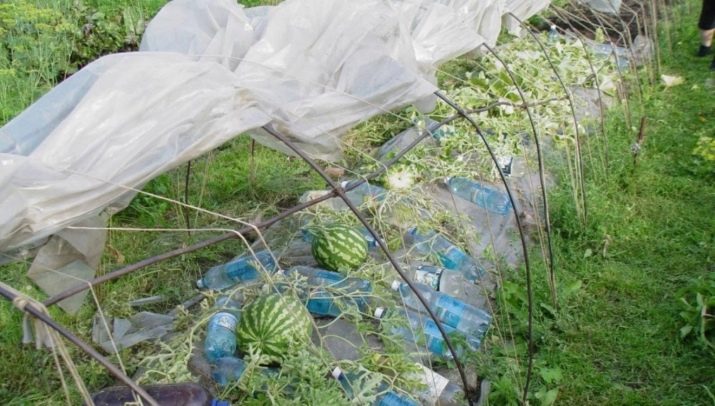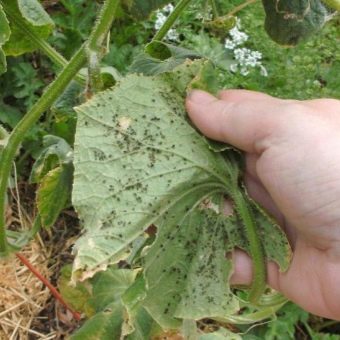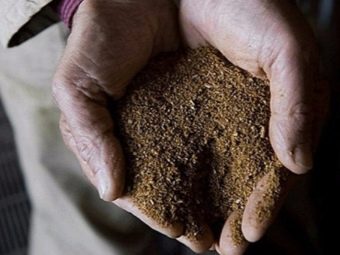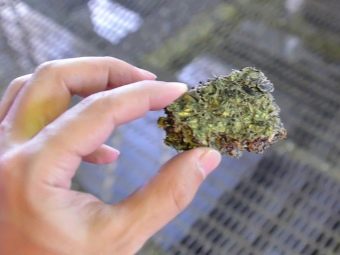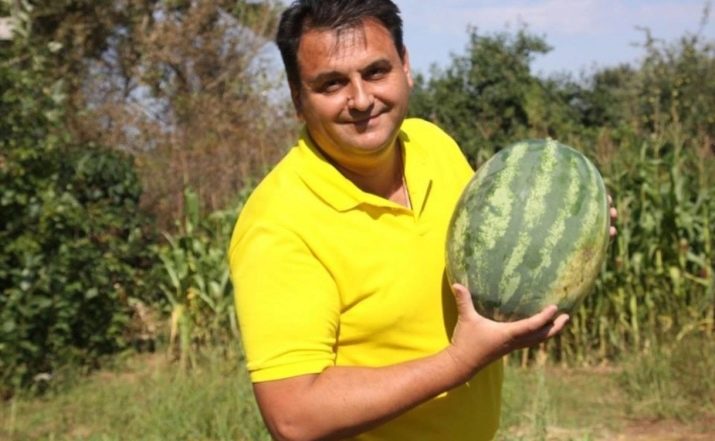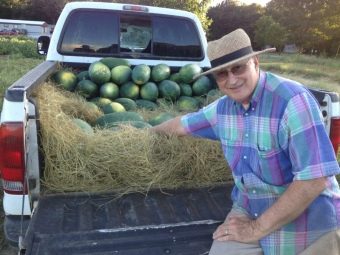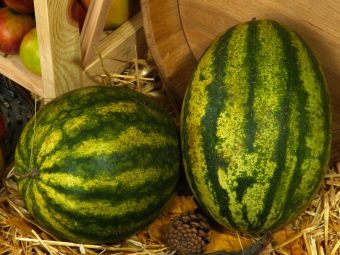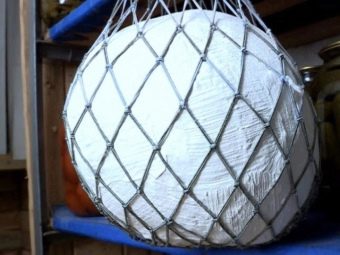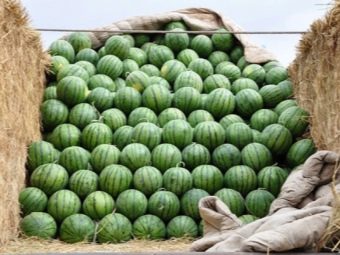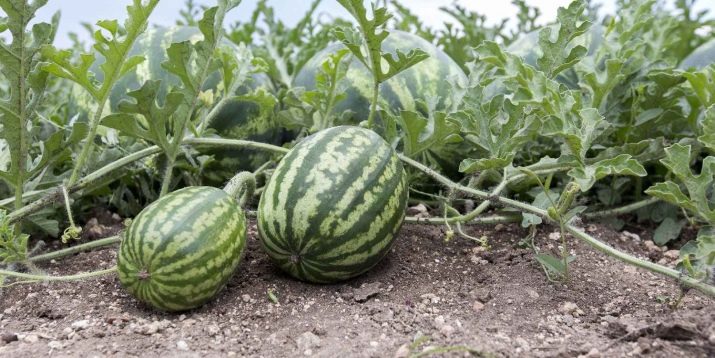The subtleties of planting watermelons in the open ground
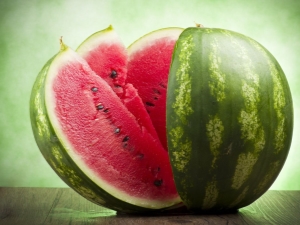
Currently, there are more and more varieties of watermelon that can be grown in open ground in regions with a cold climate.It is not so simple, but if you approach the rules of planting and growing with full responsibility, then at the end of the summer season it is possible to get a large and sweet watermelon.
Features of culture
The plant belongs to the family of pumpkin. Homeland watermelon is considered the south of Africa. The ancestor of the giant berry we know is colocinth, which is still growing in South Africa and Namibia.
Currently, the plant is cultivated on a large scale in China. It is also often grown in Iran, Turkey, Egypt, the USA, Russia and Uzbekistan. The most preferable climate for culture is an area with a hot and arid summer period and a short winter.
The shoots of the plant are thin creeping shoots that branch and twist. The length can reach 4 meters. In the period of youth culture shoots thick. The leaves are rough, hard, pushing. Their shape is triangular, and at the base the leaf is heart-shaped. The length of the leaf plates on average is 8-22 cm, width - 5-18 cm. The culture blooms in the summer. It can have not only male and female flowers, but also hermaphrodites.
The fruit is a giant berry, filled with seeds. The surface is smooth to the touch. The flesh has a bright red, pink or pale pink color, depending on the stage of ripening and variety, but there are varieties with yellowish flesh and rough shells. The fruit is sweet and juicy.
There are more than a thousand species of watermelon, but recently seedless watermelon has become widespread. It is grown by a special method, using pollination. The next generation can be obtained by treating the variety with a special compound. In general, it is impossible to call it absolutely seedless, there are still seeds in it, but they are small and soft, and the flesh can be used with them.
The advantage of watermelon is the combination of taste and benefit in it. There are not so many people in the world who would not like the taste of sweet watermelon. This berry can strengthen the immune system. In addition, it can be called effective prevention of oncology.
A special feature is the ability to remove excess fluid from the body. Slags and toxins, salts and sand also come out with water. A significant amount of folic acid makes the product useful for pregnant women. This substance strengthens the hematopoietic system and has a positive effect on the development of the nervous system of the unborn baby, increases lactation.
This is one of the favorite dishes of people suffering from diabetes. Patients can enjoy the sweet watermelon flesh without harming their health. In addition, watermelon is able to rid the body of cholesterol, weakens diseases such as gout and atherosclerosis.
Beta-carotene, which is part of the watermelon, allows you to overcome stress. This is a kind of antidepressant that helps restore the nervous system and relieve mental tension.
It is recommended to use this giant berry and people in old age. Phenylalanine protects them from Parkinson's disease.
The content of citrulline provides active work of the heart, dilates blood vessels and increases male potency.
Well suited to the use of watermelon for women seeking to lose weight. Firstly, it removes excess water, secondly, it saturates the body with sweet pulp, which allows reducing the amount of other products used.
Watermelon can cope with the following diseases:
- anemia;
- gastritis;
- ulcers;
- obesity;
- liver and kidney disease;
- constipation;
- disorders of the urinary system;
- aesthetic skin problems.
Before drinking watermelon, it is worth remembering about some harm that this fruit can cause:
- do not use the product with colitis and diarrhea;
- in case of kidney diseases, it is necessary to consult a doctor, pyelonephritis and kidney stones - a strict contraindication;
- it is better to abandon its use in case of problems with the prostate and pancreas.
The main harm that watermelon can bring to the body is associated with a large number of nitrates. These substances are filled with watermelon when grown, so that the fruit ripens faster and grows in size. High nitrate levels can cause poisoning.
To avoid unpleasant consequences, you should choose a watermelon from a trusted seller. It is necessary to abandon the purchase of cracked and chopped fruit. The content of nitrates can speak yellowish fibers on the pulp, its excessive brightness, glossy skin.
The most correct way to protect your body from nitrates, which supply the fruit during cultivation, will be an independent cultivation of berries. The following conditional variations are suitable for this:
Colocint It has a rounded leaf type and yellow single flowers. Differs in small fruits. When ripe, the green and smooth shell turns yellow. The flesh is white and has yellowish seeds. There is no smell. The benefits are in the content of protein, liquoside, chloroform, pectin. Used by folk healers in the treatment of constipation, kidney disease, dropsy. It is possible to grow in a climate with an annual rainfall of up to 1500 mm, a temperature in the range of 14–24 degrees, and does not tolerate low temperatures.
- Ordinary. It has more than a thousand species. It blooms in the summer. It ripens in late summer and early autumn. It may have spherical, cylindrical, oval or simplified shapes. Weight varies depending on growing conditions. The flesh is sweet, red, but species with white or yellow flesh are known. Stems are flexible and thin. The most common variety most preferred by gardeners for growing.
Square. It is not necessary to consider this subspecies as a separate variety. This is the same watermelon, but its shape is created artificially. The view is designed for easy transportation and storage. The fruit is placed in a wooden form at a time when its size is no larger than an egg. When growing a square watermelon, it is worth remembering that it is better to make a box for creating a form with a door opening on one side - this way there will be no problems with “rescuing” the fruit from the box. Vents are cut through the sides. When the watermelon reaches the desired shape, it is removed and left under the sun so that the shell turns green.
Any kind of watermelon is suitable for growing. The rules of their landing and care are almost the same.
Timing
The planting time and ripening period of the watermelon usually depend on the planting region of the crop. It is important to choose the right variety that will withstand the conditions of a particular climatic environment. In any case, such a thermophilic plant has a rather long growing season.
Usually transplanting in open ground is done when the shoots reach the age of 30 days. Therefore, sowing, as a rule, begins in the middle or end of April.
In the south of Ukraine, in Krasnodar and Transcaucasia, a warm and sunny climate prevails, and therefore the fruits here develop in an accelerated mode. It is possible to grow the culture immediately in the open ground. And already in the north of Ukraine, where it is not so warm, it is necessary to plant seedlings before planting.
In Moscow, Siberia, St. Petersburg or the Far East it is impossible to get a good harvest, but a moderate amount of fruit will be obtained even in a moderately cold and severe climate. However, in this case, you should follow the simple rules:
- it is important to choose a precocious variety for cultivation;
- you need to plant a crop in a greenhouse, in the middle lane you can use a film;
- planting is done by seedling;
- if you put planks under the fruit, this will avoid their rotting;
- no more than a pair of fruits should be left; if they arrange berries of average weight, then it is allowed to leave 5-6 berries.
In the Moscow region, it is recommended to choose the following varieties:
- "Sugar Kid";
- Skoryk;
- "Light";
- "Astrakhan";
- "Top Gan."
For the Leningrad region the most preferred varieties such as:
- "Kharkov";
- "Russian size";
- "Rose of the Southeast";
- "Rapid";
- "Favorite Farm Pyatigorsk."
In the Urals, you can use varieties that are used in the suburbs, plus:
- "Pink Champagne F1";
- "Polosatik";
- "Gift of the North";
- "Honey";
- Krimstar.
Varieties suitable for planting in temperatures of Siberia and the Far East:
- Crimson Wonder;
- Crimson Sweet;
- "Upper Dutin";
- "Ultra Early";
- "Siberian".
In total, residents of the middle zone can prepare for harvest in 70-80 days. Fruit weight should reach 2-6 kg.
It is important to remove the berries only when they are ripe, but not earlier and not later. The first stage of readiness comes about five days before full maturity, that is, at this time they can already be removed. If you collect unripe fruits, then most likely they will remain unripe, as they do not ripen in storage. Overripe berries are not intended for long-term storage.
The exact dates can not be established, it all depends on the variety. Usually for different species the following harvest periods are considered correct:
- fast-growing varieties (Skorik, Sugar Baby) - late July-early August;
- mid-early (“Ultraearly”) - beginning and mid-August;
- middle ripening (“Barrel of honey”) - the end of August and the beginning of September;
- Middle Late (“Chill”) - middle and end of September;
- Late-ripening (“Icarus”, “Snowball”) - the beginning and the middle of October.
Schemes and rules
The rules that must be followed when planting watermelons are not complicated, but it is important to be guided by them. Each stage of planting requires special conditions.
Site preparation
When choosing a site, be guided by the following aspects:
- It should be a well-lit place. In the shadows it is impossible to get a good harvest. Be sure to protect the area from the wind.
- Places with close groundwater storage will not work. This is due to the fact that the culture is quite drought-resistant.
- The choice of soil should be done in favor of sandy or sandy soil. The acid content in the soil is neutral. An excessive amount of acidity threatens the appearance of small fruits with a weak skin.
Particularly fertile land culture is not required. It is possible to land both in black soil and in rocky soil. But some additional feeding is still necessary. It is better to do this before planting, and then additional fertilizers will not be needed during cultivation.
Usually gardeners recommend using superphosphate, azofoska, ash (1 l per m2) or humus (5 l per m2) for a plant.
Seed preparation
Having carefully prepared the soil, proceed directly to the landing. This can be done by seedling, and you can immediately plant the seeds in the ground in the open air. In any case, watermelon seeds must be carefully prepared.
The special attention is demanded by a choice of a grade. You should choose a hybrid depending on the climatic conditions of a particular region.
An important aspect is the sorting of seeds. For this, planting material is poured out of the packaging and the largest specimens are selected. They have a high content of nutrients that will entail their effective development and good harvest.
To activate the biochemical processes in the seed tissues, the seed must be warmed and soaked. These actions will ensure good germination, the formation of female flowers, high-quality development of the loop. For this:
- pour out the seeds in a cloth packaging and drop them in warm water (50-60 degrees), withstand for 2-3 hours;
- after that we place the container for 30 minutes in a warm, weak solution of potassium permanganate;
- take out the bag, wait for the liquid to flow;
- then we put the planting material in wet sand or on a paper backing, where after a couple of days at room temperature it should begin to germinate.
In modern specialized stores, some manufacturers offer already processed seeds - in this case, they can be planted immediately.
It is extremely important to harden the planting material. This will enhance its resistance to a sharp change in temperature conditions, as well as contribute to the abundance of the crop. Summer residents prefer to carry out quenching by one of two methods:
- Sprouted seeds are placed for 1-2 days in a refrigerator at a temperature of 0-1 degrees. They need to be systematically shifted from place to place. The same actions can be made by placing the seeds in a container and placing it in the snow.
- Swollen planting material is placed in the refrigerator for 12 hours at a temperature not lower than 6 degrees. The next 12 hours, the seeds should be held at a temperature of +18 - +20 degrees. Actions must be repeated for three days.
Before planting, the seeds need a little dry.
Seeds
Planting seeds directly into open ground is possible only in the conditions of the southern region. It is necessary that the air temperature was not lower than 12 degrees, and the earth warmed to a level of 10 cm. The most successful period for this is the last decade of May. If the soil has not yet had time to warm up, then the period of seed germination will increase markedly, resulting in their death or infection.
Stages of planting germinated seeds in open ground:
- we pierce a hole of one meter diameter to a depth of about 30 cm; we introduce humus, ash or sand;
- fill the planting area with two liters of water;
- when moisture is absorbed, put 4-5 grains in the hole to a depth of 3-6 cm;
- sprinkle with soil and compact.
It is worth remembering that the gourd culture is growing widely, and future plant specimens should not interfere with each other. Use the following schemes when planting:
- when planting early varieties, it is recommended to observe the distance between future shoots of 1.4x1.4 m or 1.4x0.7 m, where the first value is the interval between rows, the second between plants;
- Late and medium grades are planted to be planted according to the scheme 2x2 m, 2.1x1.4 m, 2.1x1 m.
As already noted, usually the seeds are lowered to a depth of 3-6 cm, but this is an average figure. For a more accurate determination of the depth in each case, you need to consider several factors:
- size of planting material: small seeds are planted at a small depth and vice versa;
- soil features: on light soil it is worth choosing greater depth, on heavy soil - less;
- moisture: seeds are placed on a wet surface.
Immediately after planting, the seeds do not need moisture. Further, they require abundant watering as the soil dries out. Usually watering is done once a week. The earth is moistened to a level of 25-30 cm.
When shoots sprout, culture thinned out. Weak samples need to be eliminated.
The process is repeated in the phase of 3-4 true leaflets. In total, each well in total should include no more than two copies.
The advantage of a giant berry grown by direct planting is its high resistance to sharp temperature fluctuations and dry summer, but in this case the harvest will have to wait longer than for plants planted by seedlings.
Seedlings
The most favorable time for planting seedlings - mid or late April. As soon as the treated seeds germinate 1-1.5 cm, they can be planted. This is done like this:
- Prepare a capacity of 0.5-1 liter, more often it is ordinary flower pots;
- we dig a hole in each hole to a depth of 3 cm and lay 4-5 seeds;
- sprinkle with earth;
- watering;
- we cover the container with glass or film;
- put the container on the window on the sunny side; indoors, avoid drafts.
To get a strong and healthy seedlings, which subsequently will give a high yield, it is necessary to properly care for young shoots. Fundamental rules:
- During the day, the air temperature in the room should be about 25 degrees. At night, it is recommended to reduce it to 20 degrees.If these conditions are met, then the first shoots will turn in 7-10 days.
- It should support 12-hour light mode. With a lack of light sprouts can stretch out and die. On gloomy days it is required to use phytolamp.
- When sprouts sprout, it is necessary to thin the seedlings. Only the strongest seedling should remain in the pot.
- Watering is carried out on a daily basis. At the same time, it is necessary to avoid the ingress of moisture on the leaves, and also try not to erode the soil.
- Drain holes should be provided at the bottom of the tank so that excess water can flow out.
- In the phase of three true leaves, shoots need to be fed. To do this, gardeners recommend using fermented mullein, diluted with water in the ratio of 1: 10. Suitable liquid complex fertilizer.
As soon as the age of seedlings reaches 30-35 days, you can proceed to transplanting into open ground. By this time at least four leaves had already developed at the shoots.
It is recommended to harden the seedlings 10 days before landing in the open air. For this, the pots are left outside for some time, each day increasing the number of hours they spend in the open air. The last 3-4 days shoots should be carried out on the street completely, before planting they must be carefully watered. Measures for hardening plants make young shoots resistant to temperature changes.
In open ground shoots transplanted in mid-June. It is better to choose the morning. Escape together with the earthy lump get out of the pot and planted in the hole, watered and covered with foil.
The plant is recommended to plant deeper than it was in the tank, so that the root collar would not collapse under the influence of the wind.
Learn more about how to plant watermelon seedlings in open ground, you will learn from the following video.
Useful tips
So that the beginner melon grower does not disappoint the harvest, experienced gardeners give useful recommendations. One of them is related to the compatibility of two different cultures when grown. This refers to the "neighbors" and "predecessors" of the giant berry.
To protect the culture from the wind, you can create a kind of shelter by planting corn, beans or peas around the ridge. In addition, these plants improve the development and taste of the fruit. If a black radish is planted next to it, then the production of phytoncides by it will prevent the occurrence of spider mites, aphids, and moths.
Melon, potatoes, and oat root can be excellent "neighbors" of watermelon. A good aid in the development of the plant will be the thistle and mar. It is possible to plant the crop near the greens, but not close to the parsley.
When choosing neighboring vegetables, do not forget that watermelons grow widely, so gardeners recommend growing near-ripe varieties.
It is necessary to mention the cultures that can adversely affect the development of watermelons in the adjacent planting:
- Avoid growing near shrubs and trees that create shade on the ridge. Watermelons require a well-lit place.
- Not the most successful satellites - strawberries, tomatoes, peppers.
- It is better not to plant near beets, carrots and radishes, as the melon crops take away a lot of minerals from the soil.
- Unwanted neighborhood can happen with relatives - pumpkins or zucchini, as well as cucumbers.
Particular attention should be paid to crop rotation. If you alternate the plant with a frequency of 3-4 seasons, then on the site becomes less insects, diseases and weeds. The same ridge can be used for melon crops for a maximum of two years in a row.
Very good watermelon grows after the following "predecessors":
- wheat;
- basil;
- dill;
- cabbage;
- Tomatoes
The most wrong decision of the agronomist is to plant a watermelon on the field after a melon, squash, zucchini. It is better to plant legumes or garlic in this place.
Useful tips from experienced gardeners apply to the cultivation of melon crops. For example, residents of northern areas use trellis when caring for a plant.This method is suitable for small low-lit ridges. The stages of their installation:
- on opposite sides of the plot, two supports are mounted at least 1.5 meters high, and between the stakes they stretch the twine;
- other ropes are attached to the string, the ends of which are fixed on the stem or the ground, the plant stems will rest on them;
- the main stem is attached vertically, the top is not attached;
- lateral shoots can be eliminated, as the flowers of the female are always formed on the main stem;
- fruits are packed in nets, and then tied to the trellis, which prevents them from falling under their own weight.
Another tip from experienced gardeners is to recommend growing a crop under a covering material. This method is preferred by many agronomists, since the method has several advantages:
- interferes with the formation of weeds;
- reduces the effects of temperature extremes;
- retains water in the ground.
A relevant method for gardeners who want to grow a culture in a short or wet summer, as the fruits ripen 7-10 days earlier. Black polyethylene, a temporary film or spunbond can be used as a covering material.
To organize cultivation under black polyethylene, gardeners propose to be guided by the following steps:
- We dig out beds of 10-15 cm in height. The distance between them should not be less than 1.5 m.
- Between the ridges swarm to a depth of 40 cm trench, put the straw in it.
- Fill the straw with urea solution. This contributes to rapid rotting.
- Top we put fresh grass, we tamp.
- The next layer is humus mixed with the ground. This structure will feed the young seedlings.
- All contents are filled with water and covered with black polyethylene.
- Holes in the form of crosses are cut on the surface, the distance between adjacent slots should be 0.9 m.
- On the edges of the film put heavy objects in order to protect against wind gusts.
- Seedlings are planted in the holes made.
Temporary film can be used as a protective material from a cold snap. In this case, the following rules should be followed:
- Mounted above the site earthen arc.
- On the installation we put on the film. The width and height of the building is about 70 cm.
Under the presented design, the fruits ripen two weeks earlier. In the case of a scorching sun and heat, the material is removed so that the culture does not overheat.
The easiest method to create a shelter for future berries is to stretch a spunbond or film on one side of the plot. These measures will ensure quick hiding of seedlings directly over the lashes in case of sudden cold.
The following helpful tips relate to disease and insect control methods. The most common diseases for melons are ascochytosis, powdery mildew, anthracnose, and peronosporosis.
Such drugs as “Ordan”, colloidal sulfur, “Abiga-Peak”, “HOM” will help to cope with the diseases. However, the best way to fight will be preliminary preventive measures. In order to prevent infection, you must adhere to the rules of crop rotation and comply with all planting and growing conditions presented above.
Most often, aphid aphids, meadow moth, and wireworms become lovers of harm to plantings. These insects can cause not only damage to the product, but also completely ruin the crop. The most effective insecticides against these pests are "Tantrek", "Aktar", "Detsis", "Fufanon".
The proven popular way will also help to destroy aphids:
- mix tobacco dust and wood ash in proportions of 1: 1;
- Use the mixture to dust the insect-damaged parts and sprinkle with water;
- after 20 minutes, the earth on the ridge should be burst in order to eliminate the individuals that fell on the surface of the site.
To cope with the tracks and the wireworm will help another folk trick:
- in the ground we pierce a hole about 50 cm deep;
- we place in it sweet vegetable remains and pieces of cake;
- we cover the recess with a shield;
- two days later, we get a bait out of a hole along with insects that have fallen into a trap, and burn them.
As already noted, it is important to remove the fruits when they are ripe. In order not to be mistaken with the degree of ripeness, gardeners advise to look closely at some signs of fruit. The following external factors indicate maturity:
- dry tail;
- a clear pattern formed on the surface;
- lack of a gray shade;
- the presence of yellowish patches on the peel;
- the scent is similar to the fragrance of freshly cut herbs;
- if you knock on the cover, you hear a ringing sound.
After harvesting, you must send the fruit for storage. This also requires adhering to some rules:
- Medium-sized berries with dense, whole-skinned skin are suitable for storage;
- do not throw fruit;
- it is better to refuse transportation on a hard surface;
- care must be taken that the berries do not touch each other;
- for storage, you must choose a well-ventilated room with a humidity of 75-85% and a temperature of 1-4 degrees.
Experienced gardeners recommend using several storage methods:
- In a box lined on all sides with dry moss. In addition, each fruit must also be wrapped in moss.
- In a box covered with wood ash. Ash is also put on top of the berries.
- Fruits can be stored in a cellar, having previously lowered each into clay, paraffin or wax. The thickness of the used product should be 0.5 cm.
- Each fruit can be wrapped with thick natural fabric and hung from the ceiling in the basement.
- Suppose a way to store the harvest on the shelves in the cellar, but for this it is worth putting thick straw on the rack.
- If the fruits are stored simply in the room, then every day they need to be turned.
For those who decide to try the cultivation of watermelons in their own area, experienced melon growers give some more general useful tips:
- If the culture is grown in the northern region, then it is worth considering the close occurrence of groundwater in the soil. From excess moisture roots undergo processes of decay. If the plant is watered not under the root, but between the rows, this will lead to the development of the root system not in breadth, but deep down, which, in turn, will save the plant from death. In dry areas, these measures are not required - here the plants themselves are rooted in depth in search of moisture.
- In the process of seed preparation, there is another way to stimulate the development of planting material. For this purpose, the seed is intentionally injured by rubbing its tip against a fine sandpaper. It is important not to overdo it. The method is applied by agronomists in the middle lane.
- When planting and growing watermelons should abandon such fertilizer as manure. It can provoke the occurrence of diseases and worsen the taste of the pulp.
Thus, it is possible to grow watermelons in the open ground in almost any region of the country, but it is important to follow all the rules and use the advice of experienced gardeners. And then even a novice summer resident will receive a high harvest with tasty juicy fruits.

